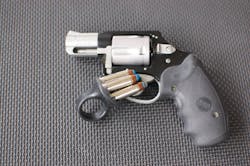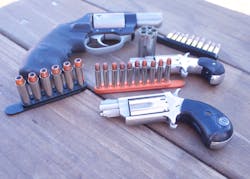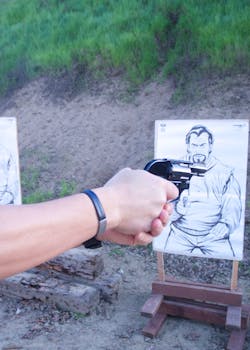Stay in The Fight
It’s no secret that I like lightweight, pocket-sized revolvers. If the uniform of the day requires a low profile, lightweight carry, then the .38 revolver is one of several choices. The trick to carrying them is a determination to stay in the fight.
What has changed since the J-Frame, the most iconic of pocket pistols, first became popular? The most obvious difference is cartridge performance—the technology is better and users have become savvy about cartridge performance. That is, officers know that the bullets must travel a minimum of 12” of ballistic gelatin, and shooting through windshields is a desirable characteristic.
The designs are so good it is hard to decide which ones to carry. For example, Hornady’s +P 110 grain Critical Defense .38 gets 1,090 fps out of a short barrel. Sig Sauer’s 125 grain +P runs about 900 fps. I have run both products through ballistic gelatin. I know what they can do in bare gelatin and after barrier, which is why I carry them.
Cartridge manufacturers have also lightened the bullets in defensive cartridges in the past few years. When J-Frames were first popular, bullets tended toward 148 to 158 grains, relying on the heavier weights to get the combination over 250-or-so foot pounds of energy. For example Cor-Bon DPX .38 Special +P rounds are 110 grains. They scream out of a short barrel at 1,050 fps and they tear up ballistic gelatin.
Revolvers are simple. They operate without magazines, can shoot a variety of different cartridges, and most products can take a lot of abuse. Revolvers require little maintenance and most users can become proficient with one with a reasonable amount of training.
The latest models are amazingly lightweight, especially considering the performance of the cartridges. For example, my EDC revolver is a Charter Arms Undercover Lite, which weighs 12 ounces. This is a 5 shot .38, through which I have run thousands of rounds. The S&W Model 360 PD, a .357, weighs 11.7 ounces. I spend time on hiking trails with my lightweight Smith & Wesson, which can handle the stream wading, rain and snow storms the Sierras dish out.Revolver selection
Officers looking for a revolver should start with the general rule of handgun selection. One should be able to consistently place a bullet within a 4-inch target at 7 yards. I’m not telling you to find a gun that accurate, as almost every gun on the market has this capability. I’m telling you to find one in which you, the user, can comfortably shoot at 7 yards.
This is not an arbitrary number—it is the furthest distance I can confidently rescue a hostage, if forced to make a hostage shot.
There are three weight ranges of pocket revolvers: 9 to 13 ounces, 10 to 22 ounces and 22+ ounces. Pick the mid-range, unless your purpose requires something very lightweight. For example, I have a friend whose two revolvers are set up exactly the same way. The 11-ounce one is just for hiking and fishing and the 15-ounce revolver is the one he carries all the time.
Reloading sequence
With training, a revolver shooter can learn to smoothly reload their revolver. Obviously, only Jerry Miculek, the world record holder for revolver shooting, will be able to keep up with Jerry Miculek, but the average shooter will be able to hold their own, too.
Let’s look at the setup and go through the sequence for reloading a revolver. The pocket revolver is carried in the right front pocket. I use Sticky Holsters for this purpose. The primary reload, which should be a speedloader, goes in the same pocket, in front of the revolver. Not only does this break up the outline, it will usually come to rest alongside the barrel, keeping everything positioned nicely. A speedloader holds cartridges in the same configuration as the cylinder of a revolver, allowing the user to quickly reload at once.
Like any other firearms training, smooth is fast. Practice this sequence slowly and gradually build up speed.
Step 1: Unlatch the cylinder with the right hand
After firing all of the rounds in a cylinder, unlatch the cylinder with the right thumb. On most models, this is done by releasing the cylinder latch. This action is done without shifting the grip. During this step, the gun is still in both hands, although the shooter begins to shift it toward the left hand.
Cylinder latches differ, depending on the make of the revolver. Any user can train to use any brand of revolver. What should the officer be doing simultaneously? He should be pulling his profile further in behind cover.
Step 2: The two fingers of the left hand push the cylinder open while the shooter shifts the gun to the left hand
Using the middle and ring finger, the shooter pushes the cylinder open. The gun is shifted into the left hand. At the same time, the shooter points the muzzle straight up and reaches for the speedloader.
Step 3: Using the left thumb, the shooter thrusts the empty brass from the cylinder
By this time, the muzzle should be completely vertical. The shooter forces out the empty brass by pressing the ejector, the nail-likeStep 4: With the muzzle pointed downward, guide the speedloader to the cylinder with the right hand
The cylinder is still pinched between the two fingers poking through the frame and the thumb. This stabilizes the cylinder so the right hand can guide the speedloader. Hold the speedloader so the cartridges are parallel to the fingers and the tips of the fingers are on the cartridges. Once the cartridges are nosed in, release them and let the speedloader fall.
This set up is deliberate. It is hard to aim the speedloader into the rear of the gun, especially under stress in low light. It is much easier, however, to learn to guide the fingertips into a circle formed by the thumb and two fingers of the hands.
Step 5: Close the cylinder with the left thumb and assume a good shooting grip with both hands—engage
Under ideal situations, a good shooter can get the reload down to around 5 to 6 seconds. Yes, slamming a new magazine is considerably faster, but practice will close the gap between the two.
The first rule to quickly reloading a revolver is to use a good speedloader. Almost exclusively, I carry 5 Star Speeadloaders. They are machined out of aluminum, which gives them a certain feel when loading the revolver cylinder. The thinner design not only allows the user to conceal them in the pocket, they clear the grips on the gun better, allowing faster reloads. 5 Star Speedloaders use a latching mechanism that releases the cartridges only when the knob at the rear of the device is turned. A ball detent prevents the cartridges from exiting accidentally. I carry these every day, practice with them regularly, and have never needed to replace them. They don’t need a lot of clearance from the frame, which make them ideal for pocket-sized revolvers.
If you want very inexpensive and simple speedloaders, use Maxfire products as they are made of molded synthetic rubber and are pretty lightweight.
Concealability and practice tips
For maximum concealability, I use Tuff Products QuickStrips. These are injection-mounded urethane strips that hold cartridges in a row, allowing the user to peel them away while pushing the rounds into the cylinder. A trained user can almost use them as quickly as a speedloader.For any gun I carry, I like to have a minimum of two reloads. At any given moment, I have 15 rounds. Usually, I carry one speedloader and a Tuff Product QuickStrip, which makes 16 rounds. They also make an 8-shot QuickStrip, which is better.
Remember, the purpose of having a handgun is to fight your way to a battle rifle. As a rule, the further away I am from backup or resupply, the more reloads I carry on my person. That is, sometimes I carry a couple of speedloaders and a QuickStrip.
One can get rounds into the cylinder rather quickly with QuickStrips—load them two at a time, peeling the strip away, while controlling the cylinder in the same manner as using a speedloader. Some users can actually feed a gun with QuickStrip with the same ease as a speedloader.
Practicing for fire continuity or keeping the gun full of cartridges should have two major components. The training sessions should have stages, which require a reload and the officer should train to reload the revolver using dummy rounds.
The training sessions I like to use go back to classic types of drills, specifically modified “el Presidente” drills. Col. Jeff Cooper originally used the el Presidente as a combat exercise drill. The shooter stands at the 10-yard line facing away from the range. The range is set with three torso targets set 1 yard apart. The shooter turns, draws and fires two rounds into the A zone of each target, then reloads and repeats the pattern. A completed course will have four hits in each target. When I was first introduced to this course, I swept from left to right, then right to left.
An easier version is the “vice Presidente,” which begins at the 7-yard line. I like to run a modified el Presidente, beginning at 3 yards, then move back 2 yards after each completion.
The shooter reloads when empty, simply because small revolvers don’t hold 6 rounds. I use dummy rounds and practice reloading from a speedloader and a QuickStrip.
When I am reloading or practicing, I repeat the mantra, “Stay in the fight, stay in the fight…” out loud. There are some things that happen in training that should give you an idea about firing under stress. Here are some rules:
- If you went to reload 5 rounds into your 5-shot revolver and only 4 rounds go in (and one hits the ground), close the cylinder and keep fighting.
- Good hits trump good reloads every time.
- Seek cover, fight your way to cover, and don’t leave cover unless the tactical situation demands it.
- Trust your abilities. You are better than you think you are under pressure.
Stay in the fight.
About the Author

Officer Lindsey Bertomen (ret.), Contributing Editor
Lindsey Bertomen is a retired police officer and retired military small arms trainer. He teaches criminal justice at Hartnell College in Salinas, California, where serves as a POST administrator and firearms instructor. He also teaches civilian firearms classes, enjoys fly fishing, martial arts, and mountain biking. His articles have appeared in print and online for over two decades.



